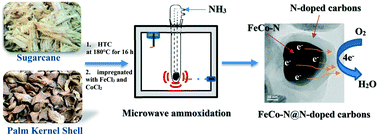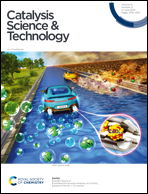Synthesis of FeCo–N@N-doped carbon oxygen reduction catalysts via microwave-assisted ammoxidation†
Abstract
A core–shell structured FeCo–N@N-doped carbon derived from biomass waste (sugarcane and palm kernel shell) is facilely prepared by hydrothermal carbonization and NH3 microwave ammoxidation methods. The fabricated carbons are thoroughly characterized by a variety of analytical techniques. The electrochemical oxygen reduction reaction (ORR), methanol resistance and durability are also tested in alkaline electrolyte. Compared to the carbons without ammoxidation treatments, FeCo–N@N-doped carbons, which contain FeCo–N in the core (evidenced by X-ray absorption spectroscopy) and highly porous carbon (verified by N2 adsorption–desorption isotherms) in the shell, exhibit superior ORR performance. Among the FeCo–N@N-doped carbons, the sugarcane-derived FeCo–N@N-doped carbon has better ORR activity than palm kernel shell-derived FeCo–N@N-doped carbon, which may be due to the more exposed active FeCo–N sites. Accordingly, the sugarcane-derived FeCo–N@N-doped carbon with a FeCo alloy ratio of 1 : 1 shows a comparable activity (onset potential 0.91 V vs. RHE), a better stability (through a four-electron pathway) and excellent methanol tolerance as compared to commercially available Pt/C catalysts. These biowaste-derived carbons with a unique core–shell structure synthesized via a simple microwave-assisted ammoxidation route can provide a promising electrode for oxygen reduction in fuel cells.



 Please wait while we load your content...
Please wait while we load your content...